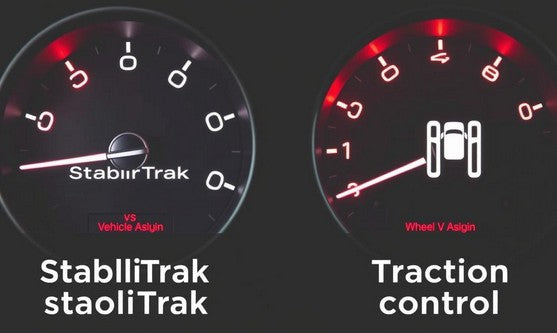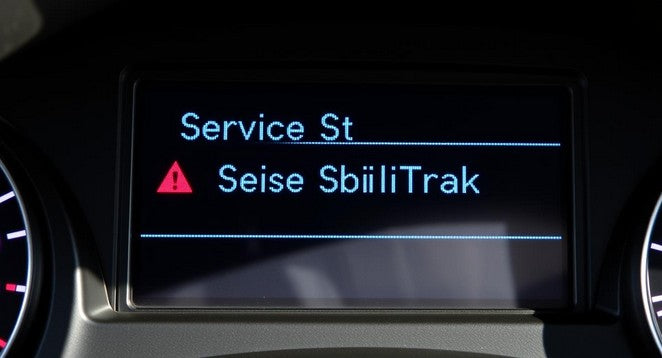When dashboard warning lights illuminate with terms like "StabiliTrak" or "Traction Control," many drivers feel immediate concern without fully understanding what these systems do. Both technologies play crucial roles in vehicle safety, but they serve different purposes and activate in different driving scenarios. This guide breaks down the key differences between StabiliTrak and traction control in simple terms, helping you understand how these systems work to keep you safe on the road.
Understanding the Basics: What Are These Systems?
Before diving into the differences, let's establish what each system is designed to do. Both systems are electronic safety features that help maintain vehicle control, but they monitor and correct different aspects of vehicle behavior.
What is Traction Control?
Traction control is the simpler and older of the two systems. Its primary function is to prevent wheel spin during acceleration. When you press the gas pedal, traction control monitors if any wheels are spinning faster than they should compared to the vehicle's actual speed.
If wheel spin is detected, the system intervenes by either applying brake pressure to the spinning wheel or reducing engine power until traction is regained. Think of it as a technology focused on the connection between your tires and the road surface.
What is StabiliTrak?
StabiliTrak is General Motors' brand name for their electronic stability control (ESC) system. Other manufacturers use different names like ESP (Electronic Stability Program) or VSC (Vehicle Stability Control), but they all perform similar functions.
StabiliTrak is a more advanced system that monitors your vehicle's directional stability. It tracks whether your car is following the path you intend based on your steering input. If it detects that your vehicle is veering off your intended path (understeer or oversteer), it intervenes to help correct your trajectory.
Technical Components: How They Work
Both systems rely on sensors and computerized control units, but they use different inputs to make decisions about when to activate.
Traction Control Components
- Wheel speed sensors (shared with the ABS system)
- Brake control module
- Engine control module
Traction control primarily uses wheel speed sensors to detect when wheels are spinning faster than the vehicle's actual speed. When this happens, the system can reduce engine power or apply brake pressure to specific wheels.
StabiliTrak Components
- All components used by traction control
- Steering wheel angle sensor
- Yaw rate sensor (measures rotation around the vertical axis)
- Lateral acceleration sensor
StabiliTrak uses these additional sensors to create a more complete picture of vehicle behavior. It compares your steering input with the vehicle's actual movement to determine if you're maintaining control. This allows it to detect and correct skids before they become dangerous.
Key Differences Between StabiliTrak and Traction Control
|
Feature |
Traction Control |
StabiliTrak |
|
Primary Function |
Prevents wheel spin during acceleration |
Maintains directional control and prevents skids |
|
When It Activates |
During acceleration on slippery surfaces |
During cornering, evasive maneuvers, or skids |
|
Sensors Used |
Wheel speed sensors |
Wheel speed, steering angle, yaw, and acceleration sensors |
|
Control Method |
Reduces power or applies brakes to spinning wheels |
Applies brakes to specific wheels to correct vehicle path |
|
System Complexity |
Simpler system |
More advanced system |
The fundamental difference is that traction control is primarily concerned with wheel-to-surface grip during acceleration, while StabiliTrak focuses on overall vehicle stability and directional control in all driving situations.
Practical Examples: When Each System Activates
Traction Control in Action
Imagine you're stopped at a red light on a rainy day. When the light turns green, you press the accelerator and your car begins to move. If you press too hard, your wheels might spin on the wet surface. This is when traction control activates:
- You might notice a pulsing sensation as the system applies brake pressure to the spinning wheels
- The engine might seem less responsive as the system reduces power
- A dashboard light typically flashes to indicate the system is working
- Once traction is regained, the system deactivates and normal operation resumes
StabiliTrak in Action
Now imagine you're driving on a highway and suddenly need to swerve to avoid an obstacle. As you make this quick steering maneuver, your car might begin to slide or skid. This is when StabiliTrak activates:
- The system detects that your car's actual path doesn't match your steering input
- It selectively applies brakes to individual wheels to help correct your trajectory
- You might feel slight braking sensations as the system works
- The StabiliTrak warning light typically flashes on the dashboard
- The system helps guide your car back to your intended path
Winter Driving: How These Systems Help
Winter driving conditions provide perfect examples of how these systems work together to keep you safe:
Starting on Snow or Ice
When starting from a stop on snow or ice, traction control prevents excessive wheel spin. Without it, your wheels might spin freely while the vehicle remains stationary. Traction control modulates power delivery to help you get moving without spinning.
Cornering on Slippery Roads
When taking a corner on a slippery road, StabiliTrak monitors if your vehicle begins to slide. If the front wheels lose grip (understeer) or the rear wheels slide out (oversteer), StabiliTrak applies brakes to specific wheels to help maintain your intended path.
In winter conditions, these systems often work in tandem: traction control helps you accelerate without spinning, while StabiliTrak helps you maintain directional control through corners and during evasive maneuvers.
Pros and Cons of Each System
Traction Control Advantages
- Helps maintain grip during acceleration
- Particularly useful in rain, snow, and ice
- Reduces driver workload in slippery conditions
- Helps prevent excessive tire wear from spinning
Traction Control Limitations
- Only helps during acceleration, not braking or cornering
- Can sometimes be too aggressive in deep snow
- May need to be disabled in certain off-road situations
- Doesn't help with directional stability
StabiliTrak Advantages
- Helps maintain directional control in all situations
- Can prevent skids before they become dangerous
- Works during cornering, evasive maneuvers, and on slippery surfaces
- More comprehensive safety coverage than traction control alone
StabiliTrak Limitations
- More complex system with more potential failure points
- Can sometimes feel intrusive during spirited driving
- May require professional diagnosis when issues arise
- Cannot overcome the laws of physics if a situation is too extreme
When to Disable These Systems (and When Not To)
Most vehicles allow you to temporarily disable traction control and sometimes StabiliTrak. However, there are very few situations where this is advisable for the average driver.
When Disabling Might Help
- Deep snow or sand: Sometimes wheel spin is needed to "dig" through deep snow or sand to reach firmer ground beneath
- Using tire chains: Some manufacturers recommend disabling traction control when using chains
- When stuck: If you're truly stuck, disabling traction control might help you rock the vehicle free
When Never to Disable
- Normal driving conditions: These systems are designed to enhance safety in everyday driving
- Wet or icy roads: Unless you're stuck, keep the systems active on slippery surfaces
- High-speed driving: The systems help maintain control at higher speeds
- If you're an inexperienced driver: These systems compensate for driver errors
Important: Most vehicles automatically re-enable these safety systems when the vehicle is restarted or when a certain speed is reached, even if you've manually disabled them. This is a safety feature to prevent drivers from forgetting to turn them back on.
Troubleshooting: When Warning Lights Stay On
If your StabiliTrak or traction control warning light stays on continuously (not flashing), it typically indicates a system fault. Here's what you should know:
Common Causes of Warning Lights
- Wheel speed sensor issues: Damaged or dirty sensors can trigger warnings
- Low brake fluid: Since these systems use the brake hydraulics, low fluid can cause warnings
- Steering angle sensor problems: Particularly for StabiliTrak warnings
- Battery or electrical issues: Low voltage can affect system operation
- ABS system faults: Since these systems share components with ABS
When warning lights stay on, both systems may be operating in reduced functionality mode or be completely disabled until the issue is resolved. This means you'll need to drive more cautiously, especially in adverse conditions.
Most StabiliTrak and traction control issues require professional diagnosis with specialized equipment. While some auto parts stores offer free code reading, the repair itself typically requires a qualified mechanic familiar with these systems.
The Bottom Line: Working Together for Your Safety
While we've focused on the differences between StabiliTrak and traction control, the reality is that in modern vehicles, these systems work together as part of an integrated safety network. Traction control handles acceleration grip, while StabiliTrak manages directional stability.
Both systems represent significant advancements in vehicle safety technology. According to the Insurance Institute for Highway Safety (IIHS), electronic stability control systems like StabiliTrak reduce single-vehicle crash risk by approximately 40% and the risk of rollover by up to 80%.
Understanding how these systems function helps you become a more informed driver and appreciate the sophisticated technology working behind the scenes to keep you safe on the road.
Find Vehicles With Advanced Safety Systems
Now that you understand the difference between StabiliTrak and traction control, you might want to explore vehicles that feature these and other advanced safety technologies. Compare Safety Ratings
Frequently Asked Questions
Can I drive with the StabiliTrak or traction control warning light on?
While you can physically drive the vehicle, it's not recommended for extended periods. When these warning lights stay on, it means the systems are either disabled or operating with reduced functionality. This significantly reduces your vehicle's safety margin, especially in adverse conditions. Have your vehicle checked by a qualified mechanic as soon as possible.
Do all vehicles have both StabiliTrak and traction control?
All passenger vehicles sold in the United States since 2012 are required to have electronic stability control (like StabiliTrak). Since stability control systems incorporate traction control functionality, all newer vehicles effectively have both systems. However, the brand names vary by manufacturer - GM uses "StabiliTrak," Toyota uses "Vehicle Stability Control (VSC)," and others use terms like "Electronic Stability Program (ESP)."
How do I know if my StabiliTrak or traction control is working?
When these systems activate, you'll typically see a flashing indicator light on your dashboard. You might also feel a slight pulsing sensation as the brakes are applied automatically or notice a momentary reduction in engine power. During normal driving when the systems aren't actively intervening, there's no obvious indication they're working - that's by design.




Leave a comment
This site is protected by hCaptcha and the hCaptcha Privacy Policy and Terms of Service apply.